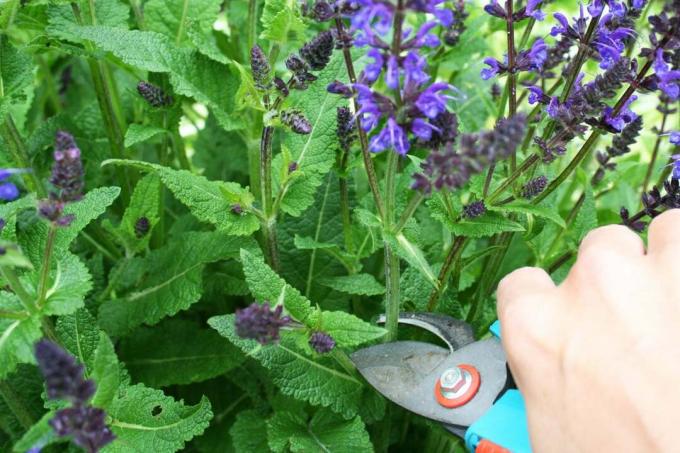
Table of Contents
- Sage growth
- Recognize ancient sage
- Rejuvenate by cutting
- time
- tool
- manual
- Care after the cut
- frequently asked Questions
Sage isn't just a flavorful herb. It also has healing properties and its flowers attract many insects. Unfortunately, it often becomes lignified over time. We'll show you how to rejuvenate sage by pruning it.
In a nutshell
- most of the sage varieties belong to the sub-shrubs
- Sage lignified in the lower area
- becomes more and more bald in old age
- Carefully cut back
- correct cut depends on the sage variety
Sage growth
The Mediterranean culinary herb usually grows as a perennial subshrub, rarely as a perennial or as a shrub. Due to its growth characteristics, older shoots lignify over time. These usually do not form new leaves and remain bare. The larger the plant, the bare the older parts. Sage also tends to break apart because of its fragile wood. This can lead to the “trunk” tearing apart close to the ground, for example due to the snow load in winter, and the shoots then lying on the ground. Although the plant usually sprouts again, it no longer grows so nicely upright and forms a lignified, bald center.

Notice: Such a plant can still be saved by rooting and replanting the shoots lying on the ground.
Recognize ancient sage
The following features indicate that the plant is aging and needs urgent action:
- old wood inside the bush
- balding shoots
- Wood cracks and becomes brittle
- Willingness to bloom diminishes
- weak or hesitant new growth
Rejuvenate by cutting
The herb should be used so that major interventions are not necessary in the first place cut regularly will. This is the best way to prevent lignification. However, if you have an older specimen in the garden that has not been taken care of and is already lignified, you can no longer avoid a more complex rejuvenation cut.

time
The right time depends on the one hand on the variety of sage, but also on the type of growth. For example, perennials can be cut back after flowering so that they bloom again. The common sage (Salvia officinalis), which is not only found most frequently in gardens, but is also most at risk from aging, is best pruned in spring. The strongest frosts should already be over, so the end of March to mid-April is most likely to come into question.
tool
The same tools as for other pruning work in the garden are suitable for cutting a sage bush:
- Secateurs
- possibly small saw
- gloves
- normal kitchen shears are also suitable for daily harvest

Notice: Because of the brittle wood, the tool really should very sharp so that the shoots do not tear off, but are cut.
manual
It is best to rejuvenate old woody sage step by step. Our guide will tell you how to properly make the taper cut.
- When pruning, the non-lignified shoots should always be shortened by at least a third, even better by two thirds. If this pruning measure is implemented consistently from the start, the sage does not lignify so quickly and rejuvenation may not even be necessary.
- It is very difficult to rejuvenate an old shrub. To do this, the old, dead shoots must first be removed. Proceed carefully, especially in the case of pronounced lignification, the branches easily break apart.
- A vigorous thinning is then carried out. In particular, cut weakly growing, little leafy areas from the shrub.
- Take a closer look at the remaining shoots. If there are younger, still green side shoots, the woody branches are diverted to them. To do this, simply cut the shoot a few millimeters above the branch.
- The most difficult thing is to rejuvenate branches that have no younger shoots, as sage does not sprout again from the old wood. If the shoot can be dispensed with, it is simply cut away at the base.
- If the branch is to remain, you can look for a sleeping eye in the woody area. This is characterized by a small thickening in the bark. If there is such a point, the shoot is shortened just above. With a little luck, the plant will sprout again at this point.

Care after the cut
Sage sprouts very slowly, especially when the old wood has been cut. The plant takes a long time to recover. It is important not to get impatient and not try to speed up the process by taking too much care. It is enough to water the plant thoroughly once and fertilize it with a little compost. A mulch cover keeps weeds from overgrowing the cut back plant. the harvest should be avoided for the time being until strong shoots have formed again.
frequently asked Questions
Other herbs that grow as shrubs tend to age too, for example lavender. Regular pruning is therefore just as important for him. A rejuvenating cut is made in a manner similar to that for sage.
These include the varieties that do not lignify, such as the steppe sage (Salvia nemorosa). It is a perennial and not a subshrub.
If certain varieties are cut into the old wood, the sage will no longer sprout. In addition, it is not good to prune in winter, as frost could endanger the plant.



